Lienhard 13
In the modern era technological change sped
up
why? change in who is inventing, where they
are working, what kind of education and funding they have
Theme of the modern era--throw out tradition and find new more
efficient ways to do things
what happens if you apply this to invention? Throw out
tradition about who develops new technologies.
- group of people working towards a particular goal
- use science
- you need business skills to bring a new product into use
- base your business strategy on new and improved products
(this works because of patents)
shift from independent inventors (using trial and error) to
industrial research labs (using science) as the predominant source
of new technology--in the 1920s
- most new products today come from industrial research
labs
- but sometimes radical new ideas come from individuals
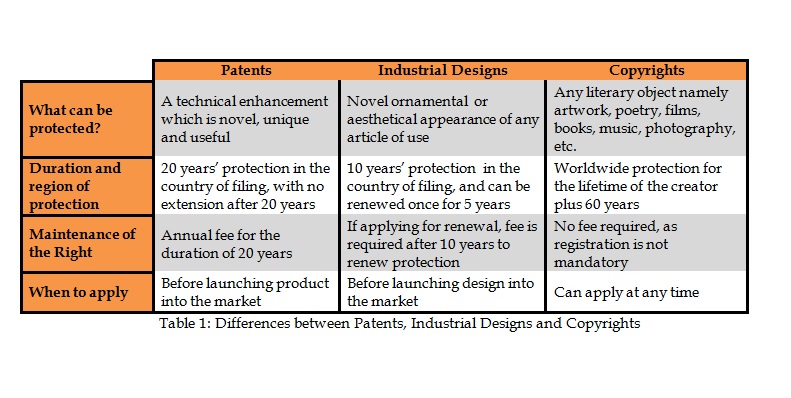
Intellectual Property (ownership of an idea):
- Patent--invention
- for 20 years from filing date (or 17 years from issue
date) no one can make your new technology without your
permission
- example--a new medication gets 20 years of patent
protection but it may take 10 years or more to do the trials
before bringing it to market
- that gives the company a chance to recover the cost of
invention and development
- once a patent runs out then anyone can make a duplicate
product and sell it for less--generic drugs
- Copyright--writing, music, art, movies
- ownership of expression
- initially copyright was for 28 years but it has been
repeatedly extended
- in 1998 it was extended to life of the author plus 70
years (for works of corporate authorship: 120 years after
creation or 95 years after publication, whichever endpoint
is earlier)
- technology is making it difficult to enforce but
- Trademark--business symbol
- based on common law, does not have to be registered
- rights to a trademark cease if it is not used for five
years
The Patent System:
- the Constitution calls for a patent system,
and it was put in place in
1790
- to
get a patent you must prove that an idea is new and
provide a complete description
- once you have a patent no one can copy your
idea for 17 years without your agreement, after that the idea
can be freely copied
- U.S. patent law doesn't require patents to be used (useless patents
)
Number of Patents granted annually by the U.S.
Patent Office (U.S.
Patent Activity, 1790-1997 )
| 1840 |
1860 |
1880 |
1900 |
1920 |
1940 |
1960 |
1980 |
2000
|
2010
|
| 458 |
4,363 |
12,926 |
24,656 |
37,057 |
42,237 |
47,169 |
47,169 |
157,494 |
219,614 |
Patents before 1836 were lost in a fire:
- the patent office was building a fireproof building, but
the old building was not only not fireproof, but in addition
the ashes from fires used to keep the offices warm were
disposed of in the basement
- there was a fire station around the corner but the
leather hose turned out to have rotted and the pump didn't
work
- 2004
story about recovering the 10,000 lost patents
- patent numbers were started again with number 1 after the
fire so the earlier patents are called x patents
recreated drawing for 1830 patent
for mechanical fan
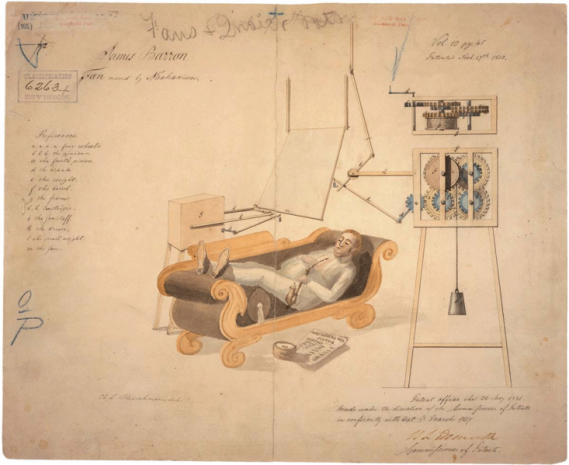
The boom in invention:
- in the late 19th century people started trying
to make their living or at least their name as inventors
- the problem is it isn't enough to invent a
gadget, you need to fit it into a system and manufacture and
market it. Some inventors were good entrepreneurs, some
were not
- what are the steps from idea to new product?
- identify (or create) a need (preferably a
bottleneck whose solution will lead to rapid progress)
- invention--a new way of accomplishing
something--probably takes research to get it right
- design/development--making that idea work
on a reasonable scale at a reasonable cost as a product
- bringing your new technology into
production--developing production and markets
- diffusion--the spread of the new
technology into widespread use
- the
whole process is rarely done by one person
- technology push vs. demand pull
- the role of consumers
Example: Charles Goodyear and the Invention of
Vulcanized Rubber
- in the early 1830s Charles Goodyear became
obsessed with the idea of improving
rubber, which was not very useful because it had a
sticky surface and it melted at high temperatures and cracked
at low temperatures
- he found a way of improving the performance by
treating the rubber with acid
- then in 1839 he accidentally dropped a
rubber-sulfur mixture on a hot stove and noticed that under
the charred surface there was a tough, springy substance
- he then spent
years figuring out what combination of heat, pressure
and ingredients worked best--he didn't have a working process
ready to patent until 1844
- so much for accidental inventions--chance
favors the prepared mind
- he was not able to make money off his
invention--he licensed out his patent to support his efforts
to develop the right product but was not successful and ended
up in debtors prison
- rubber tires and rubber condoms were among the
successful early products, but there were all sorts of other
ideas. Goodyear alone: "churned out more than a thousand
rubber inventions, including rubber inkstands, syringes,
breast pumps, dolls, gas bags, air cushions, windmill sails,
wheelbarrow wheels, bellows coverings, horse collars,
imitation buffalo robes, and something he called "baptizing
dresses." (source was a Discovery Online article that
is no longer available )
- in 1898 several men started the Goodyear
Company, naming it in honor of the inventor who had died
in 1860, $200,000 in debt
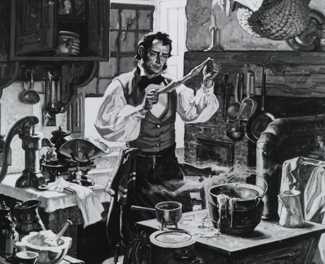
Charles Goodyear experimenting
(source was a Discovery Online article that is no longer available
)
The boom in invention lead
to ideas about how manage invention more effectively:
Competition by innovation: make your
company successful by continuous development and patenting of new
products
Example: Eastman Kodak (History
of Kodak) 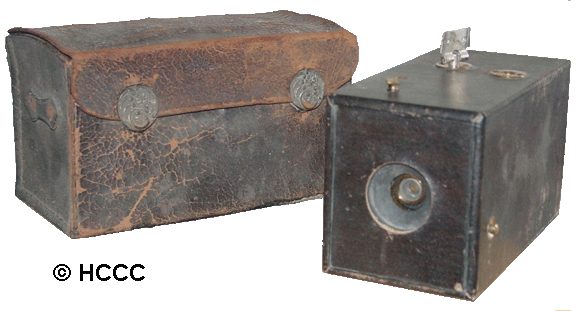
- invention of photography: 1839 Daguerreotype,
1855 wet
collodian plate, 1880 gelatin
dry plate
- George
Eastman started mass production of dry plates in 1880,
but other companies got into the business and it quickly
turned into a price war
- George Eastman wanted to avoid this by
inventing and patenting improvements--he hired a research
scientist to work on product improvements in 1886
- developed roll film in 1885, but professional
photographers didn't buy it
- 1888 started to produce a camera for amateurs
- this turned out to be a great success--he had
invented a new market
Kodak #1
What is the pattern in this boom in invention?
- enthusiasm for invention--modern era interest in new ways
of doing things
- businesses come to see developing new products as a key
strategy for competition
- invention is becoming more based on science
- science education becomes more available and more
practical
Three things change:
- Science becomes more useful
- science education becomes more widespread
- businesses figure out how to organize invention using
science
In the late 19th century technology became more based in
science (because science has progressed and is more
useful)--this also speeds up progress
- science was becoming more useful in the 19th
century, where earlier scientific theory hadn't been of much
practical use (increased role of science #2)
- electricity--the battery was invented by
Alessandro Volta in 1800: a scientist who worked out the
basic laws of electric current
- the basic laws of thermodynamics were
worked out in the first half of the 19th century, as
people tried to understand how to design better steam
engines.
- Second law of thermodynamics (entropy)
laid out by Sadi
Carnot in 1824 in a book analyzing steam
engines.
- The first law of thermodynamics
(conservation of energy was stated in the 1840s by Robert
Mayer and Hermann
Helmholtz on the basis of physiology, and by James Joule
(a Manchester brewer and amateur scientist) on the
basis of experiments (he proved the point in 1843 but
had trouble getting it published).
- development of organic chemistry in the
second half of the 19th century--in the 1860s German
dyestuff companies had turned to chemistry professors at
the universities for new organic dyes. The result
was aniline and alizarin dyes--very successful
- scientists were doing more practical research
(increased role of science #3)
- sometimes in universities with industry
funding
- particularly in the industrial research
labs that developed in the early 20th century
Engineering
and
science
education
was
a
new thing--early 19th century universities taught mostly Latin and
Greek literature, a little science and mathematics.
There were a handful of engineering schools before the civil war
but only 5% of practicing engineers had an engineering degree in
1871.
Morrill
Act became law in 1862 (full
version), in the absence of opposition from the
southern states (first proposed 1857, attacked on grounds of
states rights and competition, passed in 1859 but vetoed on
constitutional grounds).
- Gave each state federal land (or land
script)--30,000 acres for each Senator and Representative--to
sell to raise money for colleges "to
teach such branches of learning as are related to
agriculture and the mechanic arts... in order to promote the
liberal and practical education of the industrial
classes..."
- problem of what to teach--engineers weren't
using much theory. Three possibilities:
- same as other colleges (classics) to
make education democratic.
- science, which was somehow the theory
behind engineering, but not in fact very useful.
- technical training (farming and shop
practice)--why go to school to learn that?
- the eventual solution to this problem
was to teach applied science, but there wasn't much of
that to teach before about 1900
how can the college provide helpful knowledge
not just to the students but to other people in the state as
well--land grant mission
-
agricultural extension service
and short courses for farmers
-
research and transmit practical
knowledge that will help the state's economic growth
- Clemson University opened in 1893 with 446
white male students who were required to be members of the
Corps of Cadets. History of
Clemson
- Focus was on agriculture, political
supporters were white populists seeking more political clout
relative to the low-country planter elite

Fort
Hill
Private engineering schools were also founded in
significant numbers in the same period:
- MIT 1861 (instruction began 1865--followed a
Russian model emphasizing teaching students to use machine
tools but not manufacture of finished products), Worcester
Polytechnic Institute 1865 (intended to train foreman
for shops, not professionals--put its emphasis on actual
production of items for sale by students in the shops), Lehigh
1866, Stevens
1871 (mechanical engineering only--no general cultural
education).
- 17 schools taught engineering in 1870 (11% of
American engineers were college graduates), 85 in 1880, 110 in
1890
- they taught science to future engineers
(school trained engineers learned more science than apprentice
trained ones)
- made engineering more scientific in order to
teach it
Also newly created: universities--granting the Ph.D.
degree (the first one, Johns
Hopkins, was founded in 1876)
- A Ph.D. is supposed to train you to do
research and discover new knowledge, not just teach you
existing knowledge
- university professors were expected to do
research, while earlier college professors had just been
teachers
- doing scientific research became
professionalized, where earlier it had been done mostly as a
hobby
Applied science:
- Engineering became increasingly scientific
- the new fields of electrical engineering
(professional society 1884) and chemical engineering
(professional society 1908) had a scientific base from the
beginning, but employment opportunities were almost
entirely with large corporations
- Starting in the 1870s engineering schools
latched onto the idea of building laboratories for
technical research or testing.
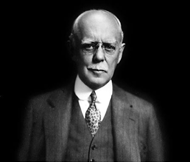
- Development of agricultural experiment
stations, particularly after the passage of the Hatch
Act in 1887.
- during World War I Arthur D. Little
articulated the concept of "unit operations," breaking
chemical engineering processes down into individual building blocks like "pulverizing,
dyeing, roasting, crystallizing, filtering, evaporations,
electrolyzing, and so on." Now there was a theory you could
teach students, instead of explaining
the process by which you make bleach.
Arthur D. Little
- Nearly all engineers entering the profession
after 1910 had engineering degrees. Applied science was
fairly well established, though what else should be taught was
still controversial
- Corporations created industrial research labs,
starting in 1905, in large numbers after 1920
- hired scientists with PhDs
- to develop new products
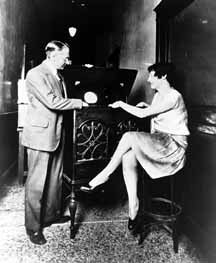
- by the eve of the first World War several
researchers had become convinced that cathode ray tubes were
the key to television. Philo T.
Farnsworth (independent inventor with only a high
school education) and Vladimir
K. Zworykin (Russian immigrant with a Ph.D. working
for RCA) developed an all-electronic, higher definition form
of television.
- In Dec. 1923 Zworykin filed a patent
for an all-electronic television, but the results were
disappointing because of the failings of the cathode ray
tube technology of the time. RCA refused to invest in
development until 1930, when Zworykin got more clout by
becoming head of the RCA industrial research lab and the
low-definition system was clearly on the way out.
- the significance was realized--the patent
was not issued for 15 years because of disputes.
- In May 1935 RCA committed $1 million to
research and development of the new technology. They
followed a careful R&D step by step program with
extensive field demonstrations in New York City. By
Jan 1937 picture definition had been increased to 441
lines--for the first time you could see a baseball
or football .
- the picture tube of the camera, however, was
not efficient enough, and Philo
Farnsworth didn't want to sell his patent on a
better one. He wanted to license it, so his earnings
would reflect its long-term success, and RCA had a policy to
not license patents (they did offer to buy it).
Finally they signed a non-exclusive cross-licensing
agreement, as each had technology the other needed.
- despite earlier disappointments, the public
was eager. But it was necessary to make sure it would
pay--industry had invested something like $13 million by
1939 and earned nothing. The advertising industry took
a wait-and-see attitude.

early
tv
But they still needed FCC approval for commercial
broadcasting (experimental
noncommercial broadcasts were allowed).
- FM radio was coming in at the same time
using the same part of the spectrum, adding to the
complications. FCC wanted to see a mature technology,
which was pretty good at this point, and also agreement over
standards, which was not. RCA had major competitors,
such as Philco, promoting rival systems.
- RCA went ahead anyway with public
broadcasting in 1939, and a number of firms started to
sell television sets (with disappointing results), but the
quick FCC approval they expected did not come. People
were reluctant to buy sets without standardization--in some
markets they could receive only one of two rival stations.
- There was a political uproar over FCC
refusal to license, but meanwhile the industry could not
agree on standards. Finally a government National
Television System Committee created in 1940 forced a
compromise.
- commercial service was finally authorized in
the spring of 1941: 525 lines, 30 frames per second.
- the interest was there--by the end of 1941
32 stations were licensed and experimenting with
programming. The first thing they learned was that
sports were popular, and increased sports
broadcasting. Dramas and news were the other main
components. Variety shows were not as popular as radio
experience would have suggested. Political coverage
was quite popular during the presidential election
- but sets could not be produced until the war
was over--in fact all radio and TV production was banned in
April 1942. By the time the war was over the
technology was there for a significantly improved receiver.
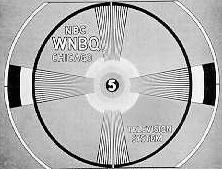
WNBQ Chicago, 1948
what has changed that has speeded up invention?
- companies are developing new products in in-house
research labs
- lots of money
- business strategy: new products and patents
- hired scientists more than engineers
- how do you come up with something new?
- old way--random ideas and trial and error
- new way--explore scientific properties and when you
find new scientific properties try to turn them into new
inventions
- technology is becoming more based on science
- need more science education
Other examples:
Current
patent/copyright issues:
- Can living things (such as genetically engineered mice
or plants) be patented?
- purified versions of natural chemicals (such as
adrenaline) were patented as chemicals as early as 1906
- hybrid plants have been patented in the US since
1930
- this was expanded to cover seed as well as plants
reproduced by grafting in 1970
- in 1980 the Supreme Court allowed the patenting of a
newly-created living organism (bacteria that ate oil), on
the grounds it was human-made through genetic
engineering. A genetically
modified mouse was patented in 1988
- In a 2012 case the Supreme Court threw out a patent
on a naturally-occurring DNA sequence (for the BRCA1 and 2
genes, but allowed patents on synthesized DNA sequences
- should Disney still
have a copyright on Mickey Mouse (created 1928) ?
- is technology making copyrights unenforceable? if
so how should creators be rewarded?








